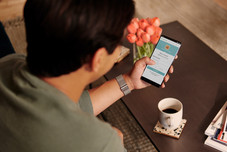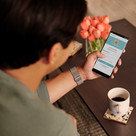Table of contents
Letting customers safely try on or test out merchandise is a growing challenge for retailers. Because of COVID-19, it’s a much bigger commitment for shoppers to leave their homes to go to a brick-and-mortar store and for retailers to allow customers to touch and interact with items.
That’s why implementing some kind of try-before-you-buy experience helps retailers meet safety guidelines while ensuring a positive experience for shoppers.
Here are a few of the ways retailers are helping customers make informed shopping decisions, but with less emphasis on physical interactions and fitting rooms.
Augmented reality try-on
Smartphone cameras and webcams are making augmented-reality (AR) shopping possible. AR tools, which overlay digital images over real ones, help customers see how various items like clothing, shoes, cosmetics, jewelry, or eyeglasses would look on them.
Shoppers can also use this technology to preview how decor items would look in their homes. These apps help customers virtually try out items in various colors or combinations before making a purchase.
AR tryout tools have seen rising use for years, with Home Depot’s popular app offering AR functionality since at least 2013. (The app shows users true-to-life 3D visuals of what Home Depot products would look like in a given space.) The pandemic, however, has accelerated the value of augmented reality for shoppers stuck at home.
Jewelry brand Kendra Scott, for example, debuted an AR app in May 2020 as it adapted to temporarily closing 108 of its physical stores. The app lets users “try on” earrings via smartphone camera.
Virtual reality design planning
Virtual reality (VR) takes the idea of AR shopping a step further, allowing customers to use VR headsets to enter entirely virtual physical environments for various shopping and tryout purposes.
To date, VR has been most commonly applied to furniture shopping and interior design. At certain Macy’s stores, for example, customers can put on VR goggles and “step in” to virtual reality renderings of their own homes, based on customer-provided dimensions and details. They can then customize wall colors and decor with items they pick out from the Macy’s digital catalog.
High-end furniture brand Natuzzi offers a similar VR experience that it believes helps customers form an emotional connection to their decor choices. Natuzzi customers wear a Microsoft HoloLens 2 headset and are fully immersed in virtual versions of the rooms they’re decorating. With the headset, they can move products around and test out different patterns and colors on items.
Ship-and-return programs
Whereas augmented reality and virtual reality give customers a way to connect with products digitally, other tryout programs put goods right in the customer’s home. Subscription box companies like wardrobe service Stitch Fix, for example, allow members to receive a set number of items every month, choose the ones they want to keep, and send the others back.
Along the way, Stitch Fix also tracks customer preferences, helping them improve their item recommendations over time. Eyewear company Warby Parker, meanwhile, sends customers five pairs of glasses to try on at home, expecting them to send back all but one.
Both companies also offer free returns and use prepaid labels to simplify the return process for customers. Small businesses looking to incorporate a ship-and-return program into their offerings should think carefully about how the costs of free returns would affect their margins, and should spend time crafting clear return policies and programs (that include sanitizing all returned items upon delivery).
In-depth product information
Retailers can minimize returns and help drive new purchases by providing a wealth of up-front resources to help inform customers’ decisions. Many brands are following the early lead of Zappos, for example, by creating high-quality photos and product videos that help customers see items in context and know what the exact colors and finishes on an item look like.
Sample-based models are another try-before-you-buy approach, where customers can get more comfortable with products prior to purchase. Birchbox, for example, charges customers $15 or less per month for a customized monthly box with several beauty or grooming samples inside. Customers get to keep all the samples and can buy full-size versions of the products on the Birchbox online store.
A small business might try a similar take on this approach by selling curated boxes of small goods selected from a collection of items, and offering them for a set price with more information (and a discount) on the full collection.
Reimagined store experiences
Online stores and social selling are more integral to retailers’ success than ever amid the pandemic. But some customers still prefer to visit physical stores and interact with products in person.
There are two key ways retailers are reimagining their physical stores to meet those customers’ needs. One is turning the store into a showroom, in which merchandise is out for display only, with store associates retrieving items from the back to try on or purchase.
The other is appointment-based shopping. Select Reformation stores allow customers to select a time for private or semi-private shopping visits, for example. And Chico’s stores go a step further by calling each customer prior to their appointment to find out what they’re looking for (which is then waiting in the dressing room when they arrive).
The importance of inventory management
Try-before-you-buy business models require the right digital toolset. Without well-synced inventory across both in-store and online channels, retailers can’t stay up to date on what’s out for try-on or available in-store for purchase. This can lead to customer confusion and the potential for lost sales.
With the right inventory management system, retailers can experiment with innovative try-before-you-buy approaches that help customers get comfortable with products without spending extensive time in-store.
![]()












